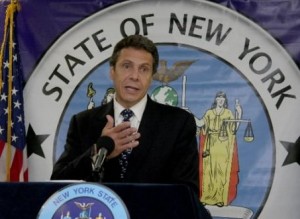Team Cuomo geared up their helmets and calculators for Tuesday morning’s budget proposal address. Governor Andrew Cuomo has made his tall task clear from the first day he set foot in Albany — he intends to close a $10 billion budget gap without any new borrowing or taxes.
Now that the Governor has officially put his charge into numbers, UR is responding by making adjustments in anticipation of state and federal cuts. Last week, President Joel Seligman sent an e-mail to the University community about the expected changes.
“The year 2011 also will have notable challenges,” Seligman wrote in his address. “Above and beyond the enduring impact of high unemployment and slow economic growth, both the new United States Congress and the new State government are likely to focus on budget cutting. I will report later in this year on the changes that occur or are likely to occur.”
In his e-mail, Seligman notes that Medicaid and Medicare are likely to experience budget constraints. By no surprise, Cuomo has repeatedly expressed his discontent with what he sees as an overfunded and unsuccessful expense for tax payers. The Governor cited the programs as one of New York’s greatest expenses, along with education and pension funds. In an effort to cut back on Medicaid and Medicare spending, Cuomo has assembled a taskforce to find reasonable healthcare savings approaches to propose by March 1.
Associate Vice President for Budgets and Planning and Deputy to the Senior Vice President and CFO Holly Crawford says that the Medicare and Medicaid cuts are going to have an impact the UR Medical Center.
“Since so much of the University is hospital and patient care related, cuts on both the federal and state levels to healthcare funding are a major concern for the medical center,” Crawford said. “At this point, it is too soon to tell the extent to which cuts will be made and, as such, we continue to monitor the development of both the federal and state budgets very closely.”
Seligman’s e-mail also mentions a review of the University’s Pell Grants and sponsored-research programs, such as those funded by the National Institutes of Health, the National Science Foundation and the Department of Energy. Crawford says that research revenue is the University’s second greatest source of income, following hospital and patient care.
In the 2011 fiscal year, UR budgeted roughly $400 million in sponsored research revenue. UR’s Pell Grants also experienced one of its highest increases in recent years, with approximately $4.5 million directed toward students.
The University is not the only institution that has been forced to tighten up its belt for Cuomo’s budget crusade.
Cornell University, for instance, has endured consistent budget cuts for the past few years. In 2009, the institution’s medical school faced eight percent cuts. According to the University’s online publication, The Chronicle, CU anticipates to cut its deficit from $102 million to $31 million by the end of 2011.
As for UR, Crawford assures that the University has an advantageously lean and flexible financial balance.
“The University has always operated very efficiently and is leaner than most of our peer institutions,” Crawford said. “Some of our peers had to make dramatic cuts during the economic crisis due to their heavy reliance on endowment spending to balance their budgets. The University has worked very hard to reduce this reliance by dampening spending and bolstering other sources of revenue (fundraising, sponsored research, etc.)”
The University’s budgeting process commences in the fall and culminates with a formal approval by the Board of Trustees in May.
The preliminary and planning stages of the budget are typically decentralized, with each department, school and division working out the details of their segment to set up the general framework of before coalescing and finalizing the budget.
In the next stage, President Seligman, Senior Vice President James Thompson and Chief Financial Officer Ron Paprocki review and make the necessary adjustments to complete the budget before its May deadline.
Prior to the board’s full approval, the Board of Trustees committees review the features of the operating and capital budget portions of the budget, including financial planning and facilities committees.
The University’s annual financial statement is a public document that is made easily accessible through the school’s website. However, aspects such as operating and capital budgets are primarily for internal use and are typically used by divisions and departments throughout the year for managerial purposes — these parts of the budget are obtainable by contacting department chairs.
Nathaniel is a member of the class 2011.






